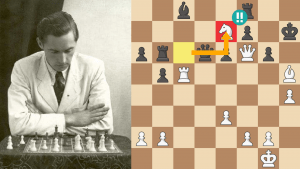
The Eye Of The Beholder
Many players feel that chess is all about threats or attack or finding a combination or some other form of brute force moves. And, of course, that is exactly what many positions need. However, in many other positions those things are exactly what you don’t want to do.
For me, the most beautiful thing about chess is seeking a way to come up with a creative move or idea that your opponent didn’t even imagine, which takes the game into unexpected pathways. The move doesn’t necessarily have to be the very best choice (it does, of course, have to be in line with the position’s deepest needs), but it’s fully playable, and forces the opponent to adjust to the new situation.
So far the game has followed pedestrian developing ideas: White has a bit more central space but Black’s e5-pawn creates a certain parity in that area. Both sides are developing their pieces and the position is more or less equal. However, Black wanted to win, and a “normal” move not only doesn’t create the energy and depth Alekhine loved, it wouldn’t pose any problems for his opponent.

Let me repeat: Black’s 11...Qd8 fits perfectly with the needs of the position. There were other ways to play, but Black’s move was full of logic and hidden poison and, perhaps most important of all, it offered quite a psychological punch.
Our next example features a position that arose from an Accelerated Dragon, Maroczy Bind.
My opponent (a correspondence chess grandmaster and FIDE master) has an edge thanks to his space advantage and Black’s overall passivity. Okay, the opening wasn’t a success for me, but I wanted to win and the only way to do that was to find a plan that conforms with the pawn structure. That means striving for a ...b6-b5 advance (not at all easy), or play for a ...d6-d5 central break.
However, saying you want to crack the center with ...d5 is one thing, but finding a way to actually do it is quite another. Since ...e7-e6 is part of that plan, one also has to accept that Black’s d6-pawn is vulnerable on the open d-file and the f6-square is also weakened.
In other words, you can’t just do it because you want to do it. You have to take all those considerations into account and find a setup that gives you a shot at making it work. Yes, Black will take on some serious risk, but the basic plan (i.e., push the d5-pawn to d5) is logical, the idea of victory was boiling my blood, and if Black can turn the position into a complicated mess, then it will be anyone’s game.
One might be thinking, “Wait a second. That’s all very well and good, but isn’t it too complex for non-masters? The answer is no, players of every class CAN come up with startling concepts (as long as you look at the position’s needs and don’t fall in love with your own tactical/attack fetishes).
Here’s one of my very favorite moves, played this year by an 11- or 12-year-old boy with a rating of 1121.
White didn’t get anything out of the opening (his 7.Be3, 9.Bg5, 11.Be3 maneuver certainly didn’t help), and finding a way to create some “zip” in his position is extremely difficult.
However, White rises to the occasion and makes a move that even a master would be proud of.
This is a very brave move! Computers hate it, but I think it’s absolutely wonderful! AND I think it hits the position’s nail on the head!
White realized that his knight on c3 is the WORST -- it can’t go anywhere or do anything. So he moves it back to b1, intending c2-c4 followed by Nc3, when he has serious pressure against d5. On top of that, c2-c4 will create an open or semi-open file, which means that a move like Rc1 will breathe life into the a1-rook (in some cases White can push the c-pawn to c5, gaining queenside space).
White can also switch plans (if Black somehow challenges the c2-c4 idea) and simply play c3 followed by Nbd2 when the knight is participating in the game.
As you can see, after 12.Nb1 White’s game goes from “I don’t have anything to do” to “I have all sorts of things I can do!”
To me, a move like 12.Nb1 is both beautiful and impressive!
Well done, Aiden! You should be very proud of your fantastic 12.Nb1. Hopefully moves like this will give the readers some food for thought.






